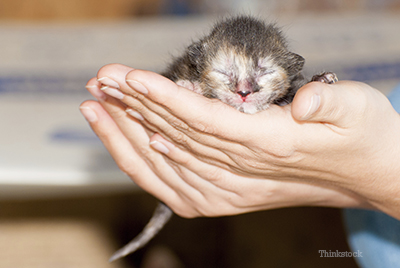
(Editor's Note, Dr. Peter Kintzer: Given the large number of homeless dogs available for adoption that would be wonderful pets and companions, very careful thought and serious deliberation should be undertaken before electing to breed your dog. Please consider adoption and click here for more information>)
In the first part of this two part posting we talked about supporting your cat during her pregnancy including trying to have a clear idea of her due date and how many kittens are on the way. Now we will talk about helping her through the big event itself.
How do you know your cat is in labor?
As we discussed in part one, towards the end of your cat’s pregnancy you should be taking her rectal temperature every day waiting for a sudden drop below 99 degrees.
When labor begins, most cats pant and vocalize and may become restless and pace around like they are looking for something. You can try to make your cat comfortable where you would like her to have her kittens (you may have a box or an area already set up), but don’t force the issue. If she chooses a different location, you should just support her there. You don’t want to upset her or disrupt her labor at this point.
In the second stage of labor, contractions become stronger and more visible and you may note a small amount of clear, tan or blood-tinged vaginal discharge. Note that it is perfectly normal for kittens to be born either head first or back-end first. Either way; according to Canine and Feline Reproduction, by Margaret Kustritz; once contractions are seen, a kitten should be born within four hours. If your cat’s pushing hard, a kitten should be passed within 30 minutes.
Third stage labor involves the expulsion of the placenta. Again, you need to be aware. Count to be sure your cat delivers the same number of placentas as she does kittens. Then, feel free to take away the placentas and dispose of them.
(Most cats are known to lick the newborns to remove the membranes and to stimulate breathing, but not all of them will. Kitten care is beyond the scope of this posting but by all means familiarize yourself with the procedures in case you do have to step in and care for the little ones.)
How do you know if there is a birth problem that requires medical intervention?
Dystocia (or difficulty giving birth) can be a serious problem for both mother and kittens. Once you know how a normal birth progresses, any deviation from that norm is worthy of a phone call to your veterinarian or an emergency clinic depending on the time of day. It’s far better to contact your veterinarian and to be told that everything is okay than it is to not call and let a problem get worse. It is advisable, however, that you call someone first because it is not in your cat’s best interest to disturb her or to disrupt her delivery by rushing her off to the hospital unnecessarily.
In fact, at one of your cat’s prenatal checkups with your veterinarian, be sure to ask when/why you should make contact. In general, though, consider calling if:
- Your cat goes beyond her proposed due date without going into labor
- You do not see evidence that Stage 1 labor has started 24-36 hours after the drop in rectal temperature mentioned above
- Stage 1 labor has not progressed to Stage 2 labor after 24 hours
- The first kitten has not been delivered after 1 hour of active labor
- It has been more than two hours without the appearance of another kitten1
- Vaginal discharge is purulent or frankly hemorrhagic
- Your cat is in apparent distress or pain or seems ill or disoriented1
- Kittens are stillborn or are alive but seem weak or not normal.
- You know that there are more kittens on the way but your cat appears to be exhausted and labor seems to have stopped. (If you had Xrays taken late in pregnancy to count the kittens, that information will now be extremely valuable.)
The key is to be as prepared as possible. Know what to expect. Know who to call. Then hopefully everything will go well and you’ll only have to contact your veterinarian after the fact to take the new family in for a routine, wellness check.
1. Kustritz, Margaret V. Clinical Canine and Feline Reproduction: Evidence-Based Answers: Wiley-Blackwell, 2009. 1st Edition.
If you have any questions or concerns, you should always visit or call your veterinarian -- they are your best resource to ensure the health and well-being of your pets.
